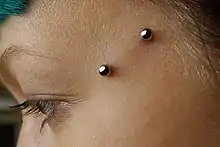Surface piercing
Surface piercings are piercings that are found on flat parts of the body, giving a double-pierced look that sits flat against the skin. A surface bar follows the plane of skin, while a standard piercing is pierced through the plane. Standard piercings have an entrance hole with an exit hole that is usually directly behind the entrance hole, whereas with a surface piercing the entrance and exit holes are next to each other on the skin surface.[1]

Types of piercings
Some examples of surface piercings:
- Corset piercing: a series of bilaterally symmetrical piercings, normally done on the back, intended to be laced like a corset.
- Christina piercing: located at the mons pubis.
- Madison piercing: a horizontal piercing located just above the collarbone, at the base of the neck.
- Nape piercing: located on the back of the neck.
- Neck piercing: located on the side of the neck. Also called "Vampire Bites".
- Hip piercing: located on or beside the hips (on the pelvis near the hips bones).
- Wrist piercing: located on or near the wrist, generally on the upper side.
- Anti-eyebrow: located under or beside the eye.
- Bridge piercing: located horizontally at the bridge of the nose.
- Pubic piercing: located in the area/ pubic bone for both men and women.
- Belly button piercing: located around or through a part of the navel
- Eyebrow piercing: this goes through the eyebrow or through the skin around the eyebrow.
Rejection and migration
Surface piercings can be difficult to heal. They are the most likely to reject as they only break through small amounts of skin. This leaves less skin to keep the piercing secure. The body sees the body jewelry as a foreign objects and can "reject" it. It will push it to the surface of the skin causing it to "grow out".[2] Proper placement and jewelry selection by an experienced body piercer can help alleviate this problem. A healed surface piercing can last from a few months to a life time.
The body resists foreign objects inside itself, and that includes piercings. Rejection occurs when it is "easier" for the body to push the piercing out like a splinter than it is to heal a fistula (skin tunnel) around it. You can spot rejection happening when there is abnormal redness around the piercing and then after a while, you can start to see the jewelry through the skin. Additionally as a recipient of a piercing you can recognize rejection or infection as a general warmth, irritation or an itchy sensation. As soon as you notice or think you notice rejection happening go to a professional body piercer or general practitioner immediately. Rejection can be dangerous and could be indicative of serious infection. Rejection is common among piercings including surface piercings, navel piercings, and eyebrow piercings among others.
Choosing an experienced piercer is also a good way to help reduce rejection. Never be afraid to ask the piercer questions on what to expect as they would know the chances of rejection for the specific piercing they will be performing and may suggest a different approach to this procedure such as different jewelry or changing the location slightly[3].
Migration is when the piercings start to move away from the original area where they were put through the skin. This is a very slow process and can be to detect. Some symptoms to look for are sensitivity or soreness around the piercing, the skin over the pricing getting noticeably thinner, they pierced hole looking larger or the piercing looking looser in general.[4]
Proper placement and jewelry selection by an experienced body piercer can help reduce the chances of both of these situations to occur. A healed surface piercing can last from a few months to a lifetime if treated properly.
Cleaning
To help decrease the chance of rejection, cleaning a surface piercing regularly is a good idea. Always start by washing your hands before cleaning your piercing. The best way to clean it is to use a saline solution or non-iodized sea salt solution, not agitating the piercing. The piercing should be cleaned a few times a day for the first few weeks. Avoid rubbing alcohol or hydrogen peroxide as they will slow the healing process by drying and killing the new healthy cells. Staying away from ointments such as bacitracin is also ideal - this limits the oxygen transport in the covered tissues [5].
References
External links
- BMEZine page on Surface Piercing Rejection - Explanation of various types of surface piercing techniques and rejection with several photos of piercings in the process of being rejected.
- Body piercing aftercare - How to properly care for your new piercing.
- Cleaning body jewellery
- Surface Piercings: Everything You Need to Know
- Body Piercings: Cleaning and Healing